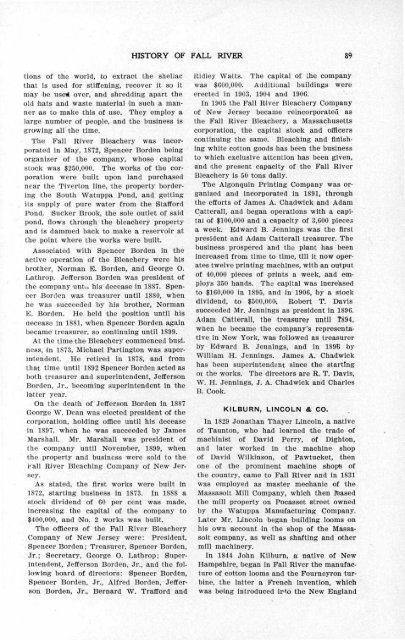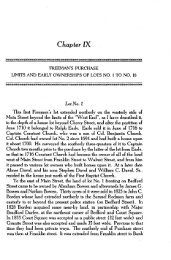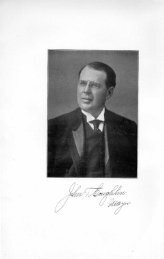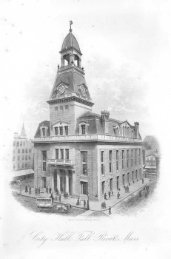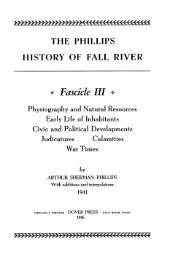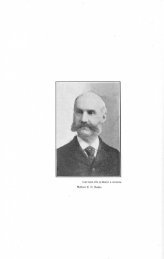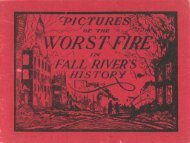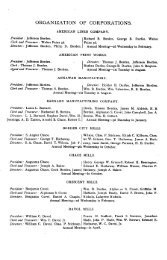Fall Rivers' Industries
Fall Rivers' Industries
Fall Rivers' Industries
You also want an ePaper? Increase the reach of your titles
YUMPU automatically turns print PDFs into web optimized ePapers that Google loves.
tions of the world, to extract the shella c<br />
that is used for stiffening, recover it so i t<br />
may be used over, and shredding apart the<br />
old hats and waste material in such a manner<br />
as to make this of use . They employ a<br />
large number of people, and the business i s<br />
growing all the time .<br />
The <strong>Fall</strong> River Bleachery was incorporated<br />
in May, 1872, Spencer Borden being<br />
organizer of the company, whose capita l<br />
stock was $250,000 . The works of the corporation<br />
were built upon land purchase d<br />
near the Tiverton line, the property bordering<br />
the South Watuppa Pond, and gettin g<br />
its supply of pure water from the Staffor d<br />
Pond. Sucker Brook, the sole outlet of sai d<br />
pond, flows through the bleachery property<br />
and is dammed back to make a reservoir a t<br />
the point where the works were built .<br />
Associated with Spencer Borden in the<br />
active operation of the Bleachery were hi s<br />
brother, Norman E. Borden, and George O .<br />
Lathrop. Jefferson Borden was president o f<br />
the company until his decease in 1887 . Spencer<br />
Borden was treasurer until 1880, when<br />
he was succeeded by his brother, Norma n<br />
E. Borden. He held the position until his<br />
decease in 1881, when Spencer Borden again<br />
became treasurer, so continuing until 1899 .<br />
At the time the Bleachery commenced business,<br />
in 1873, Michael Partington was superintendent.<br />
He retired in 1878, and from<br />
that time until 1892 Spencer Borden acted a s<br />
both treasurer and superintendent, Jefferso n<br />
Borden, Jr., becoming superintendent in th e<br />
latter year .<br />
On the death of Jefferson Borden in 188 7<br />
George W. Dean was elected president of th e<br />
corporation, holding office until his decease<br />
in 1897, when he was succeeded by Jame s<br />
Marshall. Mr. Marshall was president of<br />
the company until November, 1899, when<br />
the property and business were sold to the<br />
<strong>Fall</strong> River Bleaching Company of New Jersey<br />
.<br />
As stated, the first works were built i n<br />
1872, starting business in 1873 . In 1888 a<br />
stock dividend of 60 per cent was made ,<br />
increasing the capital of the company t o<br />
$400,000, and No. 2 works was built .<br />
The officers of the <strong>Fall</strong> River Bleacher y<br />
Company of New Jersey were : President .<br />
Spencer Borden ; Treasurer, Spencer Borden ,<br />
Jr .; Secretary, George O. Lathrop; Superintendent,<br />
Jefferson Borden, Jr., and the fol -<br />
lowing board of directors : Spencer Borden ,<br />
Spencer Borden, Jr ., Alfred Borden, Jefferson<br />
Borden, Jr., Bernard W. Trafford and<br />
HISTORY OF FALL RIVER 8 9<br />
Ridley Watts. The capital of the company<br />
was $600,000. Additional buildings were<br />
erected in 1903, 1904 and 1906 .<br />
In 1905 the <strong>Fall</strong> River Bleachery Compan y<br />
of New Jersey became reincorporated a s<br />
the <strong>Fall</strong> River Bleachery, a Massachusetts<br />
corporation, the capital stock and officer s<br />
continuing the same . Bleaching and finishing<br />
white cotton goods has been the busines s<br />
to which exclusive attention has been given ,<br />
and the present capacity of the <strong>Fall</strong> River<br />
Bleachery is 50 tons daily .<br />
The Algonquin Printing Company was organized<br />
and incorporated in 1891, throug h<br />
the efforts of James A . Chadwick and Ada m<br />
Catterall, and began operations with a capital<br />
of $100,000 and a capacity of 3,600 piece s<br />
a week. Edward B. Jennings was the firs t<br />
president and Adam Catterall treasurer. Th e<br />
business prospered and the plant has been<br />
increased from time to time, till it now operates<br />
twelve printing machines, with an output<br />
of 40,000 pieces of prints a week, and employs<br />
350 hands. The capital was increased<br />
to $160,000 in 1895, and in 1906, by a stoc k<br />
dividend, to $500,000. Robert T. Davi s<br />
succeeded Mr . Jennings as president in 1896 .<br />
Adam Catterall, the treasurer until 1894 ,<br />
when he became the company's representa -<br />
tive in New York, was followed as treasure r<br />
by Edward B. Jennings, and in 1896 , b y<br />
William H. Jennings . James A. Chadwick<br />
has been superintendent since the startin g<br />
of the works. The directors are R . T. Davis ,<br />
W. H. Jennings, J . A. Chadwick and Charle s<br />
B. Cook.<br />
KILBURN, LINCOLN & CO .<br />
In 1829 Jonathan Thayer Lincoln, a nativ e<br />
of Taunton, who had learned the trade of<br />
machinist of David Perry, of Dighton ,<br />
and later worked in the machine sho p<br />
of David Wilkinson, of Pawtucket, then<br />
one of the prominent machine shops of<br />
the country, came to <strong>Fall</strong> River and in 183 1<br />
was employed as master mechanic of the<br />
Massasoit Mill Company, which then lease d<br />
the mill property on Pocasset street owne d<br />
by the Watuppa Manufacturing Company.<br />
Later Mr. Lincoln began building looms o n<br />
his own account in the shop of the Massa -<br />
soit company, as well as shafting and othe r<br />
mill machinery.<br />
In 1844 John Kilburn, a native of Ne w<br />
Hampshire, began in <strong>Fall</strong> River the manufacture<br />
of cotton looms and the Fourneyron turbine,<br />
the latter a French invention, whic h<br />
was being introduced into the New England


